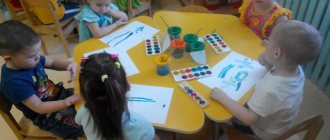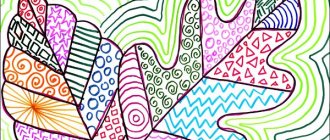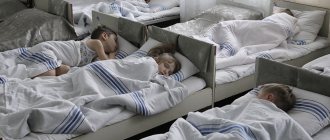Summary of educational activities during restricted periods for children of the 1st junior group
A brief summary of direct teaching activities during the regime for boys of the 1st junior group on the topic:
"Water, water..."
Integration of educational areas:
“Cognition”, “Communication”, “Narrative reading”, “Work”, “Socialization”, “Music”.
Tasks:
Improve your self-washing skills for your hands and face.
Teach children to correctly name hygiene items.
Continue to develop the skill of using a custom towel and comb.
Develop independence and tactile sensations.
Develop cultural and hygiene skills.
Expand your vocabulary: scented soap, towel.
Activate words in children’s speech that denote action: wash, roll up sleeves, lather, wash with soap, comb hair.
Continue teaching your children how to answer the simplest questions.
Methodological techniques:
A game situation showing the teacher, the teacher's actions with the children, the teacher's questions and the children's answers, explanation, showing toiletries, reading children's poems, excerpts of poems, offering children the opportunity to complete words and sentences while reading children's poems and familiar poems.
Preparatory work:
Talking about the purpose of soap, how it happens; studying plot images depicting objects used for washing, using in educational games “Wonderful Bag”, “We will teach Katya to wash”, “Misha visiting Masha”, “Dolls for the bath”. We got acquainted with water, with its property, where it can be found... We learned new sit-down games “We woke up...”, “Washbasin” (a gray rabbit washed his face as a guest...), nursery rhymes, finger games, reading excerpts from a poem by K.I. "Dirty Girl" and other works.
Equipment
: a bag of soap of different colors and shapes, a towel, a comb, a drawing.
Strike:
Children are included in the group.
Educator: Guys, look how many guests we have today. We say hello to them (stand in a circle).
Guys, how beautiful, neat, neat you are. I see you are in a good mood today.”
The teacher invites the children to play a little.
The teacher shows the movements, reads the text of the poem, and the children repeat after the teacher.
Woke up early in the morning (marching in place),
Have a fun, noisy stretch (stand on tiptoes, spread your arms up to the sides);
What else to read: Didactic games on the topic “Toys”, material on the world around us (senior group) on the topic
To make the dream go away, they yawned
The head was slightly shaken (turns left and right. Hands are placed on the shoulders).
Woke us up by running on the spot (running on the spot),
They ran to the bathroom together (they will do the “spring” exercise. Hands on the belt.)
Calendar and thematic planning in the second junior group “Safety Week”
Morning
Free activity under the supervision of a teacher.
Goal: to train the ability to ask for toys and exchange them. Develop friendships.
Outdoor Activity: Encourage children to observe indoor plants. Offer to water the plants yourself without climbing on the leaves. To foster a caring attitude towards plants, to consolidate children’s skills and plant care skills.
Morning exercises
– general improvement of the body, development of coordination of movements, training of motor skills.
Game exercise “The doll washes itself” Purpose: to teach children cultural and hygienic skills, pay attention to the sequence of actions, teach children to thoroughly wash their hands and face, explain why they need to dry themselves thoroughly. Develop a careful attitude towards your health.
Conversation “Safety in our group” Goal: consolidate the knowledge of your group, develop the ability to navigate the group’s space, a sense of security and self-preservation; enrich the understanding of the accessible subject world, the purpose of objects, the rules for their safe use; reveal accuracy, respect for group objects.
KHL “Confusion” by K. Chukovsky and nursery rhymes “Tilibom, Tili-bom...”.
Purpose: to give basic ideas for handling matches and hot objects, to clarify how the heroes managed to put out the fire. To cultivate a sense of empathy and joy for the characters of the works.
P / N “Crow and Dog” Purpose: to teach to imitate the movements and voices of birds; learn to move without interfering with each other, increase the craving for physical activity.
Work before bed.
CGN and self-care skills training.
Continue to culturally accustom yourself to behave at the table (eat carefully and independently, chew food well, use a spoon, hold it in your right hand, do not crumble when getting up from the table, push the chair slowly, thanks to the adults.
Learn on your own, take off your clothes before going to bed and fold them neatly on the high chair.
KHL fairy tale “Golden comb rooster”. Goal: to continue learning how to behave in the house when you are suddenly alone, to form the idea that you cannot open the door for anyone.
What else to read: Construction games, their originality, educational value.
Relaxation before bed - listening to folk lullabies. Purpose: to prepare children for bed.
Evening
Health-improving exercises after sleep. Hardening: air baths. Purpose: strengthening immunity and general well-being.
Walk along the “Health” trails. Goal: prevention and correction of flat feet, development of a sense of balance and coordination of movements.
Breathing exercises “Look” Purpose: articulatory breathing training; coordination of hand movements with chest breathing movements.
Consideration of the illustration by Yu. Vasnetsov “Cat House”. Goal: to teach children to carefully examine the illustration, noting the main thing and details in it; develop perception and memory, speech; cultivate a desire to help those in need.
D/I “What kind words do we know?” Goal: to form a culture of communication and a culture of behavior, to continue to teach children to use words expressing a request, gratitude “please”, “thank you”, to teach them to say hello and goodbye, to use the words “see you later” next time.” Cultivate the desire to be an educated child.
Situational conversation “Contacts with strangers” Purpose: To consider and discuss with children the dangerous situations of possible contacts with strangers on the street; Teach your child to behave correctly in such situations. Cultivate a respectful attitude towards yourself.
D / D “What burns, what doesn’t burn” Purpose: to give children an idea of the benefits and dangers of fire. Reinforce your knowledge of what burns and what doesn't. Expand your vocabulary. Develop interest in the game
P/U “Semaphore” Purpose: to strengthen children’s ability to act on a signal; continue to know the designations of traffic lights, consolidate knowledge about colors, cultivate a desire to know the rules of the road.
Research Institute “Tanya the Doll Got a Cold” Goal: to develop independence in choosing roles, develop the ability to use substitute objects, promote the formation of the ability to use a handkerchief, and cultivate a caring attitude towards others.
Autonomous activity in the creativity center: Painting with colors “Car with wheels”. Goal: to teach how to draw rounded lines - wheels, to teach how to hold a brush freely, to draw paint on a brush, to remove excess paint, to increase accuracy in work.
Regular moments in the senior group in the afternoon
Summary of routine moments in the afternoon in the senior group “Forest Fairy Tale”.
MBDOU "Debesky kindergarten No. 1" Raising children
- Strengthen the ability to make a bed: straighten a sheet, cover it with a blanket;
- Improve the ability to dress and undress independently in a certain sequence;
- Formation of knowledge about a healthy lifestyle during awakening gymnastics;
Massage Mat
After the children begin to wake up, we begin awakening gymnastics. We use a complex of awakening gymnastics.
Preparing for afternoon tea
- develop self-service skills;
- Improve washing skills;
- form a CGN (wash hands before eating);
- Strengthen skills on duty: set the table with cutlery and dishes, napkins;
- To form the concept of a healthy lifestyle during rinsing and hygiene procedures in the bathroom.
Cups of salt water;
Teaching material: illustrations, board games
After all the girls have combed their hair, I suggest that all the guys brush their teeth and rinse their necks with a special solution of salt water. Goal: prevention of throat diseases.
I invite the dining room attendants to help set the table for afternoon tea.
Evening exercises after sleeping on the carpet, all together listening to music.
Evening circle. Children sit in a circle. Evening greeting. In a circle:
— finger gymnastics, “My Family”
One two three four
Who lives in our apartment?
Dad, mom, brother, sister, cat Murka, two kittens, my puppy, a cricket and me - that’s my whole family!
- articulation gymnastics,
“Smile” counting from 1 to 5 (hold)
“Tube” counting from 1 to 5 (hold)
Alternating “Smile”, “Tube”.
— Individual work with 5 children: pronouncing phrases,
didactic game for the development of speech and the formation of elementary mathematical concepts “Find the corresponding number and say it”
— physical education minute
Goal: getting children in the mood for the upcoming activity.
After the tables are set, I invite the children to wash their hands and come to the table.
I ask the children, what are we going to do now?, thereby fixing part of the day.
Afternoon snack
- improve skills: hold a fork with your thumb and middle finger, hold it on top with your index finger; eat different types of food without changing the position of the fork in your hand, but only slightly turning your hand.
- Improve the ability to cut a piece of cutlet (meat).
I remind you that you are not allowed to talk at the table.
When I eat
I don't listen to anyone
I pay attention to correct posture at the table while eating. Using my own example, I show you how to use cutlery correctly. I help the attendants read out the menu. I wish everyone a bon appetit.
I draw the children’s attention to the composition of the afternoon snack and the importance of each product for the child’s body (vitamins, minerals, etc.)
After an afternoon snack, I suggest rinsing your mouth with water. Purpose: preventive measure against caries.
Independent activities of children
Create conditions for the role-playing game “Shop”
- Control and observation of children during independent play activities.
Toys: dummies of vegetables and fruits, handbags, drawn money, cash register, counter, costumes for sellers, etc.
A gradual transition to the organization of a plot-role-playing game “Vegetable Store” or “Fruit Store” at the children’s choice. Offer the role of the seller to a low-active child in order to activate speech and communicate with peers, and perform the role until the end of the game. Buyers name the color and shape of an object in order to develop coherent speech. I pay attention to the children’s relationship with each other during the game.
Independent play activities for children in centers according to their wishes and interests.
Create conditions in the artistic corner:
- offer glue and scissors
- Goal: consolidation of application skills.
Ready-made templates and stencils, glue, scissors, visual material
I suggest some children do some applique work. As an example, I show an autumn leaf cut out of paper. I suggest choosing paper of any color you like and getting to work. I remind you that after working with glue you need to put everything back in its place.
Individual work with children
- Development of coordination of fine movements of the fingers
Sheet of paper and pencils
Game "Magic Pattern". I suggest coloring in view of the patterns. You need to decorate with pencils of different colors. I remind children how to hold a pencil correctly; do not go beyond the contours, etc.
Preparing for the walk
- Improve the ability to dress independently in a certain sequence;
- Strengthen the ability to properly place your things in the closet
- Educate KGN
I suggest the children go to the toilet. Let me remind you that boys come after girls.
Before going out to the locker room, we wait for “Silence”, then in such silence we get dressed gradually. I make sure that the children follow the sequence.
Exercise “Dress on command”: whoever is wearing tights and a sweater can wear pants. Now you can wear jackets and hats. Let me remind you that clothes need to be tucked inside to keep warm.
I give a positive assessment to children who dress correctly, quickly and quietly. I draw attention to those who need help.
Walk
Observation
- Form ideas about the autumn months;
- Learn to independently find signs of autumn in the environment;
- Systematize ideas about the state of plants in late autumn;
- vocabulary work: leaf fall, late autumn, short-term, herbarium;
While walking, I suggest that children observe seasonal changes in nature.
We highlight the weather features (in September it is colder than in August, rain, fog, the sun is shining but not warming). In November, late autumn sets in, there is snow on the ground.
We cultivate a caring attitude towards nature and plants.
Outdoor game “Tea-tea-help out”
(OVD - running)
- learn to act in harmony with each other.
- Learn to navigate in space
- Create positive emotions
I invite the children to gather in a circle and use a little counting rhyme:
On the golden porch sat the king, prince, king, prince, shoemaker, tailor, who are you, come out quickly, don’t detain good and honest people.
I'm getting the kids ready for a game. I remind you of the rules of the game. We choose a driver.
Individual work
- Sasha P – practice throwing at a target
Goal, ball
I suggest Sasha play “Hit the Target” ball. I explain how to hold and throw the ball. We train by doing several repetitions.
Goal: strengthening throwing skills.
Work assignments
- Learn to carry out the teacher's tasks
- Remove toys from the area
Broom, rake, gloves
Labor activity on site:
— Cleaning leaves;
— Sweeping on the veranda;
— We collect fallen leaves for the herbarium;
Working with parents
- Conversation about the child's achievements
When the children go home, I talk with the parents about the child’s achievements.
I suggest some parents pay attention to the child’s health, since he had a cough or runny nose during the day.


